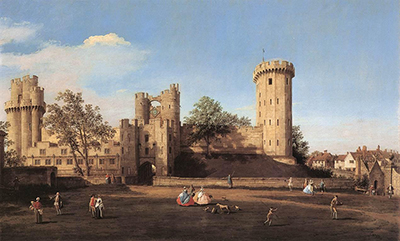Warwick Castle: the East Front by Canaletto was painted back in 1752 after Canaletto's trip from Venice and it contains an exterior section of this famous castle. It further highlights a glimpse of the town towards the right of the painting.
The painting further includes a blue sky as well as animated figures that depict the liveliness from the exterior point of view of the Castle. Besides the visitors and servants, the painting depicts dogs around the Castle. Also, apart from the significant buildings, Canaletto includes other small houses to the left side. The inclusion of the buildings, animals and people gives an impression of the reality of the painting with regards to the conditions of the Castle. Canaletto further embraces contrast as he uses both bright and dull colors. Whereas the people in the paintings are adorned in bright colors, the buildings and the dogs are shown in dull colors. The central theme of the painting is the Warwick Castle, a structure which is found in Warwickshire, England. The painting measures 73 by 122 cm, and its medium was oil on canvas. Currently, it is located in the Birmingham Museum and Art Gallery in Birmingham.
In his work, Canaletto inspired different artists. For instance, through the Warwick Castle: the East Front art, John Constable found the inspiration to visit Warwick in 1809 after which he came up with drawings with instant reactions in the walls and the east of the medieval buildings. He further sketched both St Mary's and St Nicholas Church towers in his art. Later on, he embraced an impressive watercolor of the Castle and the specific town. He further inspired Joseph Wright work as he came up with a painting named Moonlight, with a Lake and a Castellated Tower in 1787. Here, he sketched the ancient Medieval Bridge alongside the thick vegetation. It depicted an atmospheric evening scene of the region. His main emphasis on the painting was a romantic association of the ancient building. Canaletto was therefore an important part of the movement towards more expressive art, particularly within the genre of landscape and cityscape art.
Finally, his paintings inspired Joseph Mallord William Turner work as he made visits to Warwick. He later came up with drawings which featured the Castle as an exciting place. He embraced bright colours and an attractive watercolour. He further manipulated the Castle to include a church to enhance the excitement in the art. Initially, Canaletto had embraced bright colours in his Warwick Castle: the East Front and this idea was embraced by Turner. There were also considerable numbers of etchings from Canaletto that were produced during his time living in the UK and these shocked many because of the incredible level of detail and craftmanship which was substantially superior to the levels achieved by local artists at the time. If we go in the opposite direction, you will also find an artist called Claude Lorrain from France who set the same wheels in motion prior to Canaletto taking things on across in Italy and this cycle is entirely typical of the route taken by European artists since the early Renaissance era.




